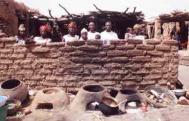WE HAD BEEN into the meeting for over half an hour. The representatives from the invited NGO had spoken, I had spoken, the village chief had spoken. But not a single woman, in this meeting about women’s needs, had uttered a word. Finally, I had to ask: “Is any woman going to talk?”
I was working as an architect in the Dogon village of Beignematou in the West African republic of Mali. I had come to this semi-arid region to help design and build the village school. I had come in 2002 to build the first phase; now, in 2005, I was back to finish the job. But I had realised during my earlier visit what problems this place suffered from: desertification, environmental degradation and malnutrition, amongst others. I was determined that the work I was doing would also improve the environment. But how?
This was where the women came in. One of the major problems in the region is deforestation, a large part of which is caused by a demand for wood for cooking-stoves. Women in Beignematou cooked on three triangularly placed stones, placed above a wood fire. It was both inefficient and environmentally destructive, and the deforestation was making the wood harder and harder to find. If more efficient stoves could be designed, they would both prevent deforestation and make life easier for the village’s women. But if it was to happen, it could not be imposed from outside – it needed to be a project of the women themselves.
Investigations took me to a nearby NGO called YA-G-TU, which had built prototypes of simple earthen stoves for just this purpose. It was a group set up and run by local women, who carried out demonstration and training programmes on these new stoves in far-flung villages like Beignematou. When the villagers heard about it they were keen to get involved.
A village meeting with YA-G-TU was organised. All the women, gaily dressed, and quite a few men of the village attended. This was the first time that the women of Beignematou had met with an outside NGO. It was natural that they were hesitant and had not spoken a word. Dicoré, one of the women of YA-G-TU knew this well. She expertly nursed the hesitant women into participating fully in the process. Soon, the project had everyone’s blessing. Six women from the village were trained in how to construct the new, energy-efficient earthenware stoves from abundant local waste materials, including donkey dung and millet chaff. Over the course of just two days, the women made new stoves for nineteen households. They were so successful that another batch followed, supplying every house in the village.
The successes of this small, local project were many. The new stoves operated for three times as long on the same amount of fuel as the old ones. They were made of renewable local materials by local people, who had been empowered and inspired by their involvement in the project – so much so that they proceeded to build themselves separate stoves for making millet beer, and are now planning to take this appro- priate technology to nearby villages.
The Mali project was realised as part of a school project with the participation of CRATerre-France, Cultural Mission of Bandiagara and
MISEREOR (Germany). [email protected]
Peeyush Sekhsaria is an architect/geographer specialising in earthen architecture and
sustainable development.








